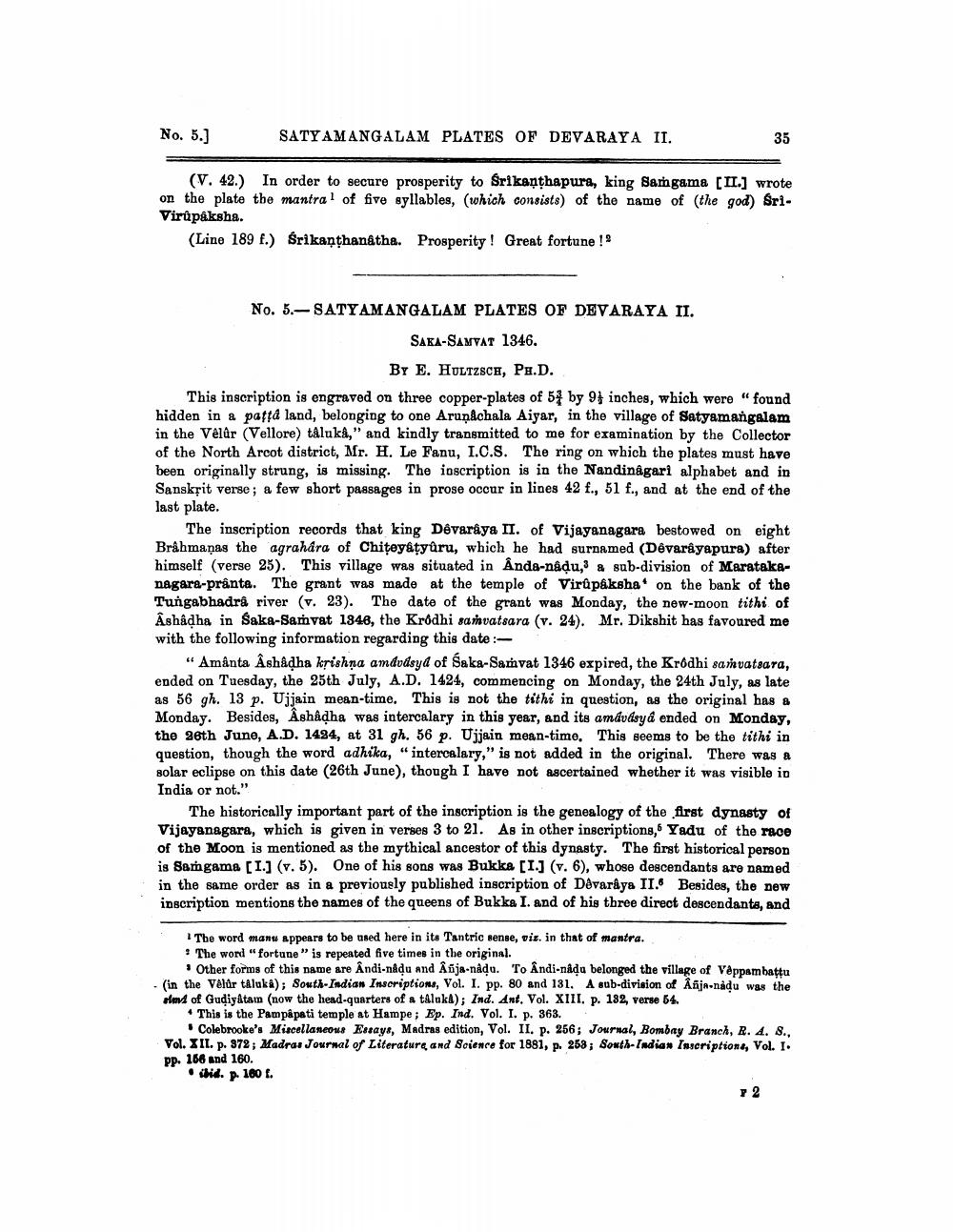________________
No. 5.)
SATYAMANGALAM PLATES OF DEVARAYA II.
35
(V. 42.) In order to secure prosperity to Srikanthapura, king Samgama [II.) wrote on the plate the mantral of five syllables, (which consists) of the name of the god) Sri. Virupaksha.
(Line 189 f.) Srikanthanatha. Prosperity! Great fortune!
No. 5.- SATYAMANGALAM PLATES OF DEVARAYA II.
SAKA-SAMVAT 1346.
By E. Hultzsch, Pa.D. This inscription is engraved on three copper-plates of 5 by 94 inches, which were " found hidden in & paffà land, belonging to one Arunachala Aiyar, in the village of Satyamangalam in the Velar (Vellore) taluka," and kindly transmitted to me for examination by the Collector of the North Arcot district, Mr. H. Le Fanu, I.C.S. The ring on which the plates must have been originally strung, is missing. The inscription is in the Nandinâgari alphabet and in Sanskrit verse; a few short passages in prose occur in lines 42 f., 51 f., and at the end of the last plate.
The inscription records that king Dêvaraya II. of Vijayanagara bestowed on eight Brahmaņas the agrahara of Chiţeyktyuru, which he had surnamed (Devarayapura) after himself (verse 25). This village was situated in Anda-nadu, & sub-division of Maratakanagara-pranta. The grant was made at the temple of Virupaksha on the bank of the Tungabhadra river (v. 23). The date of the grant was Monday, the new-moon tithi of Ashâdha in Saka-Samvat 1946, the Krodhi sanvatsara (v. 24). Mr. Dikshit has favoured me with the following information regarding this date :
"Aminta Åshedha krishna amdvdsyd of Saka-Samvat 1346 expired, the Krodhi samvatsara, ended on Tuesday, the 25th July, A.D. 1424, commencing on Monday, the 24th July, as late as 56 gh. 13 p. Ujjain mean-time. This is not the tithi in question, as the original has & Monday. Besides, Ashadha was intercalary in this year, and its amdvdsyd ended on Monday, the 26th June, A.D. 1424, at 31 gh. 56 p. Ujjain mean-timo. This seems to be the tithi in question, though the word adhika, "intercalary," is not added in the original. There was a solar eclipse on this date (26th June), though I have not ascertained whether it was visible in India or not."
The historically important part of the inscription is the genealogy of the first dynasty of Vijayanagara, which is given in verses 3 to 21. As in other inscriptions, Yadu of the race of the Moon is mentioned as the mythical ancestor of this dynasty. The first historical person is Samgama [1.] (v. 5). One of his sons was Bukka [1.] (v. 6), whose descendants are named in the same order as in a previously published inscription of Devaraya II. Besides, the new inscription mentions the names of the queens of Bukka I. and of his three direct descendants, and
The word manu appears to be used here in its Tantric sense, vis. in that of mantra. • The word "fortune" is repeated five times in the original.
· Other forms of this name are Andi-nadu and Abja-nado. 'To Andi-nåda belonged the village of Véppambattu . (in the Velar taluka); South Indian Inscriptions, Vol. I. pp. 80 and 131. A sub-division of Afija-nadu was the om of Gudiyatam (now the head-quarters of a taluka); Ind. Ant. Vol. XIII. p. 182, verse 54.
• This is the Pampåpati temple at Hampe; Ep. Ind. Vol. I. p. 363.
Colebrooke's Miscellaneous Essays, Madras edition, Vol. II. p. 256; Journal, Bombay Branch, R. 4. 8., Vol. XII. p. 372, Madra. Journal of Literature and Science for 1881, p. 268 ; South Indian Inscriptions, Vol. I. pp. 166 and 160. • shid. p. 160.
2




